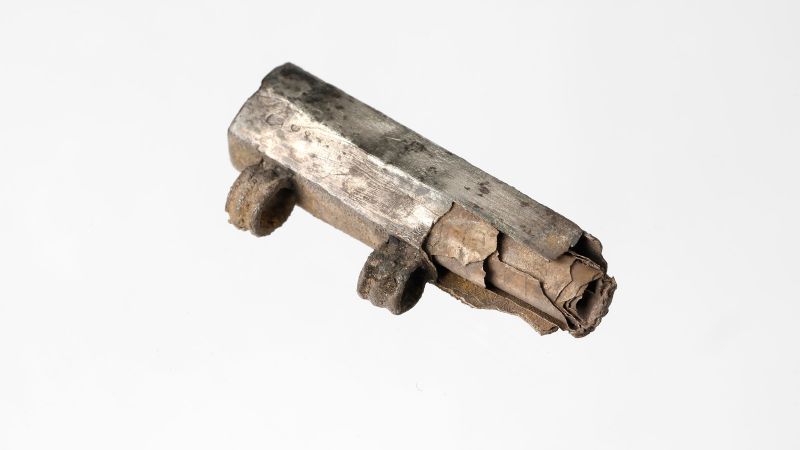A remarkable discovery made by archaeologists in Germany has the potential to significantly alter the way experts understand the spread of Christianity throughout the Roman Empire. This significant artefact is a small silver amulet, approximately 1.4 inches (or 3.6 centimeters) in length, that was unearthed in 2018 from a Roman grave situated just outside Frankfurt. The grave itself dates back to the 3rd century and was found in the ancient Roman city of Nida, one of central Germany’s most important sites located in the state of Hesse.
The amulet, discovered under the chin of a male skeleton in the grave, was located alongside several other notable artefacts, such as a clay jug and an incense burner. Often referred to as a phylactery, this type of amulet was likely worn around the neck to provide spiritual protection to the bearer. Inside the amulet was a thin, hair-like silver foil, which proved extremely delicate. Initial attempts to unfold it would have resulted in its total degradation, but a series of microscopic examinations and X-rays conducted in 2019 revealed that it bore engraving of words, leading researchers to ponder what it might communicate.
It wasn’t until May of this year that researchers from the Leibniz Center for Archaeology in Mainz (LEIZA) utilized advanced CT scanning technology to analyze the fragile foil effectively. According to Ivan Calandra, the head of the imaging laboratory at LEIZA, the process was exceptionally challenging given that the foil had been rolled and subsequently creased and crushed over nearly two millennia. Through high-resolution scanning, the team was able to create a 3D model that allowed the complete text to be deciphered without physically handling the silver piece.
The breakthrough revealed astonishing findings—18 lines of Latin text that frequently mentioned Jesus Christ and St. Titus, a close disciple of the Apostle St. Paul. Given that the grave dates between 230 and 270 AD, the amulet stands as the earliest verified evidence of Christianity known in Europe north of the Alps. Prior discoveries associated with Christianity in this area are typically dated at least 50 years later, underscoring the significance of this find.
During the period of the burial, Christianity was on the cusp of becoming more widely accepted, though identifying oneself as Christian remained perilous. The buried individual, estimated to be between 35 and 45 years old, evidently held a profound commitment to his faith—the spirit of which he carried even to his grave.
Markus Scholz, an archaeologist from Frankfurt’s Goethe University, meticulously deciphered the text inscribed on what is now known as the “Frankfurt Silver Inscription.” The task was arduous, and he collaborated with experts in theological history to gradually uncover the text. His revelation about the writing being entirely in Latin was unexpected, as it was common for such inscriptions during that era to be created in Greek or Hebrew.
Translated, the inscription contains various phrases that convey reverence towards St. Titus and Jesus Christ, referencing biblical quotations, including a passage from Philippians 2:10-11. The absence of references to other faiths is significant, as it was uncommon in that era.
Experts including Wolfram Kinzig, a historian from the University of Bonn, emphasized that this silver inscription is one of the oldest pieces of evidence concerning the spread of the New Testament within Roman Germania, highlighting its historical importance. Furthermore, the discovery allows for unique insight into how biblical verses were once employed in protective contexts for the deceased.
Peter Heather, a medieval history professor at King’s College London, hailed the find as extraordinary, particularly due to modern technology’s role in enabling the deciphering of previously inaccessible texts. He noted that finding such evidence of early Christianity in a frontier area like Roman Germany is not only unusual but marks a significant step backward in the timeline of Christian history in that region.
This discovery unveils the complexities of early Christian faith and its practitioners and raises many questions about the expansion of religious beliefs across disparate regions in the ancient world. As more research is conducted, this amulet may prove foundational in tracing the threads of Christianity’s evolution in Europe.



